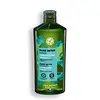What's inside
What's inside
 Key Ingredients
Key Ingredients

 Benefits
Benefits

 Concerns
Concerns

 Ingredients Side-by-side
Ingredients Side-by-side

Water
Skin ConditioningSodium Methyl Cocoyl Taurate
CleansingCocamidopropyl Betaine
CleansingSodium Cocoyl Isethionate
CleansingLauryl Glucoside
CleansingParfum
MaskingAsparagopsis Armata Extract
Skin ProtectingSodium Benzoate
MaskingGlycerin
HumectantCitric Acid
BufferingGuar Hydroxypropyltrimonium Chloride
Skin ConditioningSodium Chloride
MaskingCoco-Glucoside
CleansingGlyceryl Oleate
EmollientPotassium Sorbate
PreservativeLimonene
PerfumingTocopheryl Acetate
AntioxidantHydrogenated Vegetable Glycerides Citrate
EmollientTocopherol
AntioxidantWater, Sodium Methyl Cocoyl Taurate, Cocamidopropyl Betaine, Sodium Cocoyl Isethionate, Lauryl Glucoside, Parfum, Asparagopsis Armata Extract, Sodium Benzoate, Glycerin, Citric Acid, Guar Hydroxypropyltrimonium Chloride, Sodium Chloride, Coco-Glucoside, Glyceryl Oleate, Potassium Sorbate, Limonene, Tocopheryl Acetate, Hydrogenated Vegetable Glycerides Citrate, Tocopherol
Water
Skin ConditioningSodium Laureth Sulfate
CleansingCocamidopropyl Betaine
CleansingGlycol Distearate
EmollientGuar Hydroxypropyltrimonium Chloride
Skin ConditioningPropyltrimoniumchloride Acrylamide/Dimethylacrylamide Copolymer
Camellia Seed Oil
Sodium Dilauramidoglutamide Lysine
HumectantSqualane
EmollientRoyal Jelly Extract
Skin ConditioningGlycine Max Seed Extract
Skin ConditioningSorbitol
HumectantPEG-2 Laurate
EmulsifyingSodium Sulfate
Dipropylene Glycol
HumectantLauric Acid
CleansingDimethiconol
EmollientSalicylic Acid
MaskingCitric Acid
BufferingDisodium EDTA
Sodium Lauryl Sulfate
CleansingButylene Glycol
HumectantTocopherol
AntioxidantPhenoxyethanol
PreservativeSodium Benzoate
MaskingAroma
CI 19140
Cosmetic ColorantCI 15985
Cosmetic ColorantWater, Sodium Laureth Sulfate, Cocamidopropyl Betaine, Glycol Distearate, Guar Hydroxypropyltrimonium Chloride, Propyltrimoniumchloride Acrylamide/Dimethylacrylamide Copolymer, Camellia Seed Oil, Sodium Dilauramidoglutamide Lysine, Squalane, Royal Jelly Extract, Glycine Max Seed Extract, Sorbitol, PEG-2 Laurate, Sodium Sulfate, Dipropylene Glycol, Lauric Acid, Dimethiconol, Salicylic Acid, Citric Acid, Disodium EDTA, Sodium Lauryl Sulfate, Butylene Glycol, Tocopherol, Phenoxyethanol, Sodium Benzoate, Aroma, CI 19140, CI 15985
 Reviews
Reviews

Ingredients Explained
These ingredients are found in both products.
Ingredients higher up in an ingredient list are typically present in a larger amount.
Citric Acid is an alpha hydroxy acid (AHA) naturally found in citrus fruits like oranges, lemons, and limes.
Like other AHAs, citric acid can exfoliate skin by breaking down the bonds that hold dead skin cells together. This helps reveal smoother and brighter skin underneath.
However, this exfoliating effect only happens at high concentrations (20%) which can be hard to find in cosmetic products.
Due to this, citric acid is usually included in small amounts as a pH adjuster. This helps keep products slightly more acidic and compatible with skin's natural pH.
In skincare formulas, citric acid can:
While it can provide some skin benefits, research shows lactic acid and glycolic acid are generally more effective and less irritating exfoliants.
Most citric acid used in skincare today is made by fermenting sugars (usually from molasses). This synthetic version is identical to the natural citrus form but easier to stabilize and use in formulations.
Read more about some other popular AHA's here:
Learn more about Citric AcidCocamidopropyl Betaine is a fatty acid created by mixing similar compounds in coconut oil and dimethylaminopropylamine, a compound with two amino groups.
This ingredient is a surfactant and cleanser. It helps gather the dirt, pollutants, and other impurities in your skin to be washed away. It also helps thicken a product and make the texture more creamy.
Being created from coconut oil means Cocamidopropyl Betaine is hydrating for the skin.
While Cocamidopropyl Betaine was believed to be an allergen, a study from 2012 disproved this. It found two compounds in unpure Cocamidopropyl Betaine to be the irritants: aminoamide and 3-dimethylaminopropylamine. High-grade and pure Cocamidopropyl Betaine did not induce allergic reactions during this study.
Learn more about Cocamidopropyl BetaineThis ingredient is derived from guar gum.
It is a conditioning ingredient, meaning it helps soften skin and hair.
Sodium Benzoate is a preservative. It's used in both cosmetic and food products to inhibit the growth of mold and bacteria. It is typically produced synthetically.
Both the US FDA and EU Health Committee have approved the use of sodium benzoate. In the US, levels of 0.1% (of the total product) are allowed.
Sodium benzoate works as a preservative by inhibiting the growth of bacteria inside of cells. It prevents the cell from fermenting a type of sugar using an enzyme called phosphofructokinase.
It is the salt of benzoic acid. Foods containing sodium benzoate include soda, salad dressings, condiments, fruit juices, wines, and snack foods.
Studies for using ascorbic acid and sodium benzoate in cosmetics are lacking, especially in skincare routines with multiple steps.
We always recommend speaking with a professional, such as a dermatologist, if you have any concerns.
Learn more about Sodium BenzoateTocopherol (also known as Vitamin E) is a common antioxidant used to help protect the skin from free-radicals and strengthen the skin barrier. It's also fat soluble - this means our skin is great at absorbing it.
Vitamin E also helps keep your natural skin lipids healthy. Your lipid skin barrier naturally consists of lipids, ceramides, and fatty acids. Vitamin E offers extra protection for your skin’s lipid barrier, keeping your skin healthy and nourished.
Another benefit is a bit of UV protection. Vitamin E helps reduce the damage caused by UVB rays. (It should not replace your sunscreen). Combining it with Vitamin C can decrease sunburned cells and hyperpigmentation after UV exposure.
You might have noticed Vitamin E + C often paired together. This is because it is great at stabilizing Vitamin C. Using the two together helps increase the effectiveness of both ingredients.
There are often claims that Vitamin E can reduce/prevent scarring, but these claims haven't been confirmed by scientific research.
Learn more about TocopherolWater. It's the most common cosmetic ingredient of all. You'll usually see it at the top of ingredient lists, meaning that it makes up the largest part of the product.
So why is it so popular? Water most often acts as a solvent - this means that it helps dissolve other ingredients into the formulation.
You'll also recognize water as that liquid we all need to stay alive. If you see this, drink a glass of water. Stay hydrated!
Learn more about Water